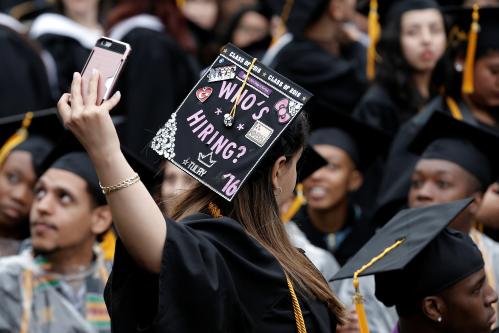In the past decade, there has been a dramatic increase in the number of American student-loan borrowers leaving college with high debt and low earnings. The resulting unsustainable debt burdens impose substantial costs on students and on federal taxpayers.
When student loan borrowers default—as nearly 1.2 million direct-loan borrowers did in 2016—the consequences are particularly severe because of collection costs, credit reporting, tax refund offsets, wage garnishment, and ineligibility for future aid. Many of these loans will never be repaid, leading the federal government and ordinary taxpayers to bear the burden of these costs.
In the face of such problems, it is disheartening to watch the Department of Education start to roll back consumer and taxpayer protections that curtail federal lending at poor performing educational programs. These regulations, such as Gainful Employment (GE), tie eligibility for federal funding to student success, and are necessary to help reduce the costs of student loans to taxpayers and to protect students from economic harm. (The Department of Education is also rewriting the so-called Borrower Defense rules, which could make it harder for victims of fraud to get out from underneath their student debt.)
The GE regulations define which for-profit and which certificate programs at private nonprofit and public institutions lead to gainful employment based on a measure of the debt-to-earnings ratio of recent graduates. Programs whose graduates experience systemically high debt-to-earnings ratios are prohibited from participating in federal aid programs.
As economists who have studied for-profit education, we believe that the case for these rules is even stronger today than when the rules were written. As we argued in a recent comment to the Department of Education (PDF download), these protections should be kept in place as currently written. The existing GE regulation targets an important, continuing problem–the large numbers of students enrolled in occupational programs who leave with low earnings and loans that they cannot repay.
We arrived at this conclusion independently, based on our own research examining student outcomes.
In our research, for example, we showed:
- Students from for-profit colleges end up with higher levels of debt, low labor market earnings, and higher rates of default on their loans. In 2009, for instance, for-profit institutions accounted for about 11 percent of all postsecondary enrollments, but about 50 percent of all student loan defaults (Deming, Goldin, and Katz 2012).
- Two years after leaving school and entering repayment on their loans, almost three quarters of for-profit borrowers owed more, because of accumulating interest and fees, than they did when repayment began. Almost half (47 percent) of for-profit borrowers leaving school in 2009 defaulted on a federal student loan over the subsequent five years. For-profit students were more likely to borrow and borrowed more each year of enrollment than other students, and across a wide variety of loan outcome measures, those borrowers faced worse outcomes than borrowers from other types of institutions (Looney and Yannelis 2015).
- Students who attended for-profit certificate, associate and bachelor’s degree programs earned less after leaving those programs than they did before enrollment; their return to attending was negative. For certificate programs, where both for-profit and nonprofit sectors can be evaluated in the GE data, earnings gains for students in for-profit institutions were lower than those for students in public institutions, even after accounting for differences in student characteristics. The for-profit students also incurred larger debt burdens than the students in comparable programs at public institutions (Cellini and Turner 2016).
- When for-profit colleges lost access to federal student aid due to cohort default rate (CDR) regulations in the 1990s, enrollment losses in the for-profit sector were entirely offset by enrollment gains in local public institutions. When poorly performing schools closed after losing access to federal aid, overall college-going did not decline, rather enrollment shifted to better-performing community colleges. (Cellini, Darolia, and Turner 2016).
Based on our work and that of others, we argued in our comment that: a) the GE regulations successfully target the occupational programs that contribute most to poor student outcomes; b) the regulation is unlikely to adversely affect college access; c) weakening the GE regulations will create burdens on taxpayers; and d) the GE information disclosure provisions are important but not a substitute for necessary accountability provisions.
Early indicators of the success of GE regulations are promising. At the time of the initial proposal of the GE regulations, the Department of Education estimated it would save the public approximately $4.2 billion over 10 years due to reductions in federal financial aid costs. Some colleges have already closed or announced intentions to close poor performing programs, or introduced trial periods and other measures to help inform students of their decision before incurring large debt to enroll in a program.
All of these signs point to the fact that GE regulations are working, and the Department of Education shouldn’t roll them back.
For more details on our argument, read the full comment we submitted to the Department of Education here (PDF download).
The Brookings Institution is committed to quality, independence, and impact.
We are supported by a diverse array of funders. In line with our values and policies, each Brookings publication represents the sole views of its author(s).











